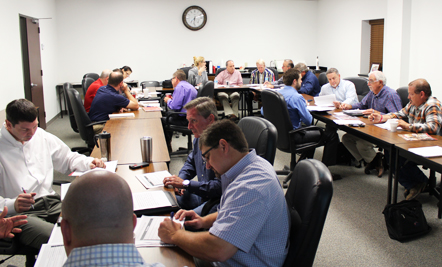 As we’ve been telling you on Construction Citizen, the ABC Houston Industrial Committee is hard at work figuring out the absolute best way forward for construction training. The committee has come up with recommendations for the full ABC Houston Board and we’d like to share some of them with you.
As we’ve been telling you on Construction Citizen, the ABC Houston Industrial Committee is hard at work figuring out the absolute best way forward for construction training. The committee has come up with recommendations for the full ABC Houston Board and we’d like to share some of them with you.
The committee agreed at a recent meeting that we’ll know success has been reached when we have a coordinated pathway for construction training and available projects can be completed locally within project goals on a sustained basis by identifying and partnering with existing resources. Those can include contractor training programs, owners, community organizations, community colleges, and high schools to develop safety conscious, high quality, universally-accepted, certified and productive craft professionals.
Achieving that will be no easy task. It will take contractors and owners stepping up to the plate in a variety of ways.
To help the board understand what must be done, the committee broke down the recommendations into things that contractors and owners can do together and things that each of those groups must do on their own for this to be successful. Make no mistake: This is a collaborative effort.
Things owners and contractors should do together:
Contractors and owners can demonstrate success by tracking results. This is key and will require a multi-faceted approach. Aligning specific results areas and creating KPIs, establishing a process for tracking individual progression from entry point to top craft professional, and supporting the transfer of training records and accomplishments across the contracting community will be essential.
There are too many barriers to participation in training. We must address language barriers, promote awareness of construction as a career path by partnering with community organizations, and incentivizing people to get involved in training.
That last item can be accomplished by getting creative. There are many opportunities to come up with new ways to extend craft professionals in training and development programs for longer periods of time. Those who demonstrate a history of training participation should move to the front of the hiring line.
Onsite training may be preferable to centralized training situations in many situations, so owners and contractors need to give that serious consideration.
And of course economic barriers cause huge problems for potential recruits. One of the challenges is that many folks simply won’t – and shouldn’t have to – surrender overtime pay while they travel to training locations. Paying for on-site training can go a long way toward tackling the challenge.
Things contractors should do:
Contractors need to work closely with owners, NCCER, CMEF and community training providers to develop “fast track” training opportunities. To do that, NCCER curriculum has to be separated into commercial and industrial tracks. Balancing industry experience with learning in the classroom is a common sense solution that’s needed now as well.
The quality and quantity of NCCER qualified teachers has to be addressed. Training plans have to be developed to implement soft skill training for supervisors to help and encourage craft professionals. Hands-on training at job sites can supplement all forms of classroom training. Clear definitions must also be established for training standards and the level of knowledge required for professional certification.
Things owners should do:
Perhaps the biggest contribution owners can make to this effort is leveling the playing field by issuing proposals and contractors that require the including of training plans and clear expectations for results.
That can be achieved by managing crew-mix ratios to provide more helpers. This is especially critical on maintenance, small cap and turn-around. A level playing field can also be achieved through balancing offsite and onsite craft training and mentoring.


